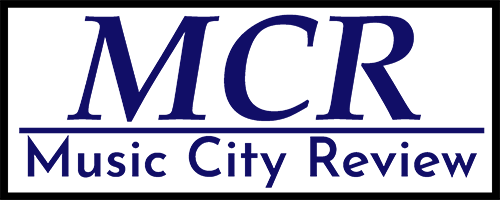Nashville, Meet Chicago
In 1920’s Chicago, two murderers try to use their celebrity and femininity to win sympathy from the press, the public, and the justice system to avoid the death penalty. About bad people in a corrupt setting, the show captures unhypocritical bad-girl energy. This dark comedy is instantly relatable in today’s hyper-connected culture with our augmented cultural fascination with crime: just think O. J. Simpson, Gypsy Rose Blanchard, and the frighteningly prompt releases of documentary films about Luigi Mangione.
Chicago is based on the 1926 play by Maurine Dallas Watkins, based on her experience as a young reporter. She worked the courthouse beat in Chicago and covered the trials of two murderesses, Belva Gaertner and Beulah Annan. These two women became the basis for Velma and Roxie in her play, two lawyers were combined into Billy Flynn, and gullible reporters became Mary Sunshine. Her play was adapted into two different movies. Later in life Watkins regretted that her reporting may have helped gain sympathy for those she was convinced were guilty of murder, and she refused Bob Fosse the rights to her play. It wasn’t until after she died that he got the rights to adapt Chicago in 1975, with the music and lyrics written by Kander and Ebb of “New York, New York” and Cabaret fame. Although it first came out in 1975, it’s the 1996 revival of Chicago that has been wildly successful, becoming the longest-running revival and the longest-running American musical on Broadway. In nice symmetry, it has won six Tonys and the film adaptation won 6 Oscars.
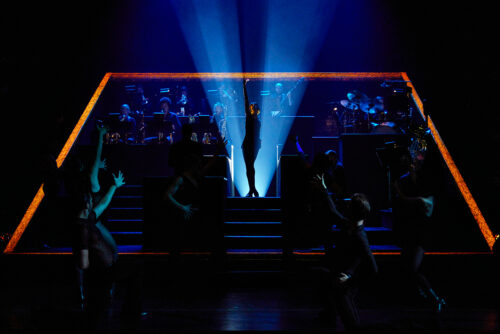
I attended the Tuesday, January 28th show at TPAC and it was a blast. It wasn’t as sold out as I’d expected or as it deserves, but the audience was fully enamored. Familiar with the show, they cheered excitedly before the big moments and responded with delight.
This production has a fantastic cast and orchestra, and since the show is one musical number after another, this is more than usually imperative. With often little and sometimes no dialogue between songs the orchestra is put to work. Not hidden in the pit but in a bandstand serving as part of the stage, the conductor and the characters occasionally interact. The musicians are the best I’ve heard all season (especially the brass), and conductor Cameron Blake Kinnear’s direction and announcer’s voice are excellent. Live music is always best, and with ten talented instrumentalists it’s even better.
The music in this show is some of my favorite Broadway music, and (with the exception of “Mister Cellophane”) all the songs are great. For readers already familiar with Chicago’s music this is nothing new, but if you aren’t and can’t make the show at TPAC, at least take the time to watch “Cell Block Tango” and “We Both Reached for the Gun” on YouTube.
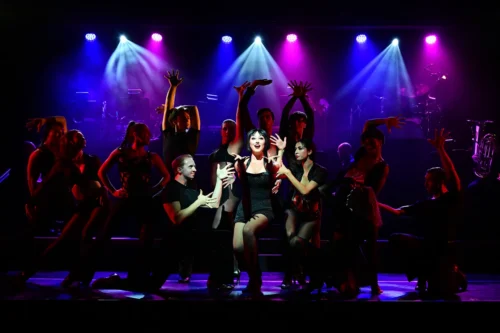
The dancing is visually exciting for the whole show. Done in the style of Bob Fosse’s original choreography, it never gets repetitive. Very often sensual, it also has a sense of fun, of humor, and sometimes downright goofiness. Somehow all of these work together to give a consistently cool vibe without getting dully sexual or jokey.
The only thing that does get monotone in the show is the minimalism and monochromatic color: black. While the original Broadway production featured color, since the 90’s revival all the costumes have been black. The set is black, the stage is mainly dim and lit by spotlights, and the few props are black (even an American flag is black and white). The only bit of color is the golden tinsel wall lowered for one number at the end. While black has always been sleek and sexy, I feel like it flattens some of the sparkle of the show and makes it difficult to distinguish characters from a distance. There are basically no setpieces beyond chairs and the occasional ladder and I wished for some visual razzle-dazzle: dancers with white feathers during Billy Flynn’s song “All I Care About” confirmed that contrast adds brilliance. This focus on black is iconic, however, so my opinion is probably in the minority.
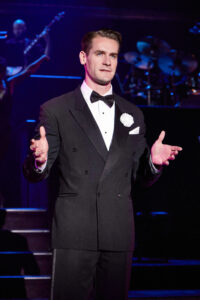
This production’s cast is outstanding. Everyone is a talented actor, dancer, and singer. Taylor Lane owns the brusque and unrepentant Velma, showcasing hard strength and a fighting spirit. Ellie Roddy nails the naive but vicious Roxie, who thinks she’s street smart by comparing herself to her gullible husband, Amos, who is played by Andrew Metzger with effective comedy. Connor Sullivan is delightful as the cynical lawyer Billy Flynn, suave and cold. Brad Weatherford makes the small role of Fred Casely very funny and memorable. The ensemble is excellent, with a strong chorus and fantastic dancers.
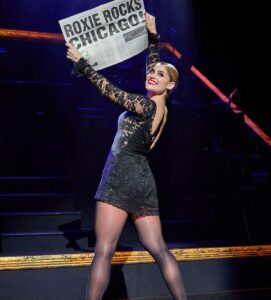
My only complaint about this production is its use of on-stage camera flashes. There are several scenes with the press when photographs are taken and it is painful: the audience is sitting in a dark room, looking at the dark stage, and then actual camera flashes sear the backs of our retinas. After the first few times we heard a few grumbles when “photographers” appeared on stage.
Besides a quick warning to squint and prepare yourself when a camera appears on stage, I can only highly recommend this production of Chicago, at TPAC through February 2nd. For tickets and more information, see Chicago | Tennessee Performing Arts Center or Chicago on Tour.
